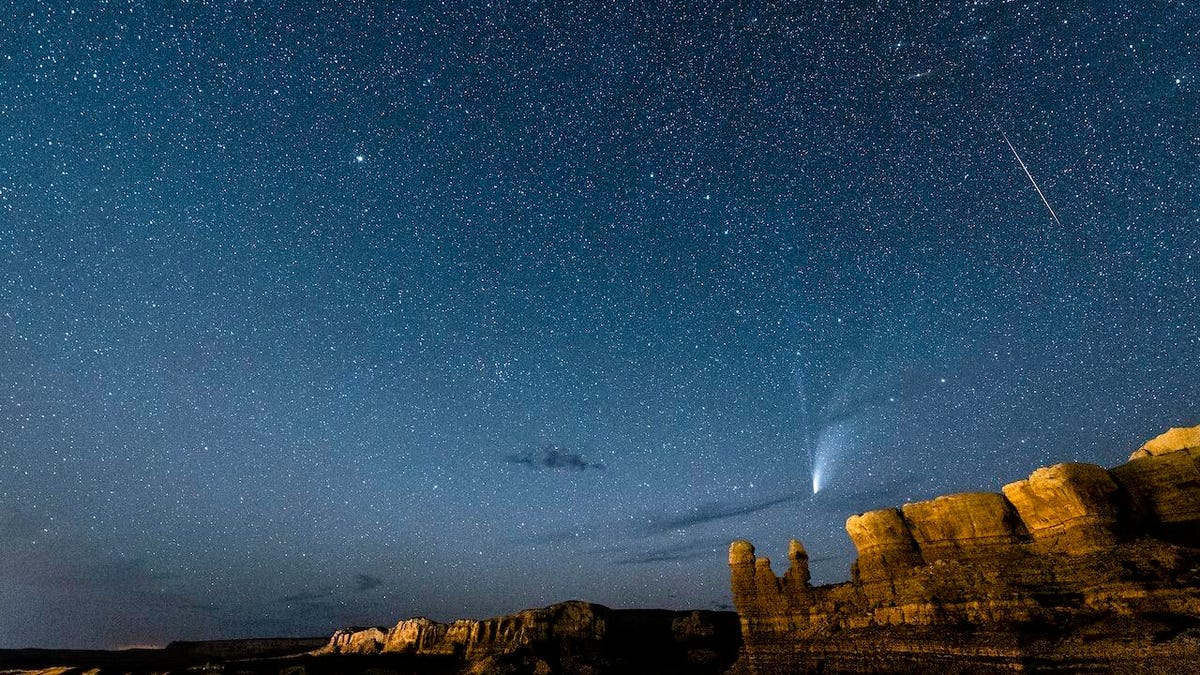A pair of meteor showers are peaking as comet Neowise fades
The brightest comet in a generation is heading back to deep space, but some big meteor showers offer a night sky encore.

Comet Neowise and a meteor captured over Bluff, Utah, on July 20.
The best nights to see bright comet Neowise are likely behind us, but skywatchers should look for it this week while also watching for meteor showers hitting their stride.
A handful of meteor showers are currently active, including the alpha Capricornids and Southern delta Aquarids that peak on July 29. Also, the moon is only partially illuminated this week and Neowise should still be visible with binoculars, leaving you little excuse not to go outside after dark and spend a little time just looking up.
Last week, I ventured out into the exceptionally dark evening of the New Mexico desert, several miles from the lights of the nearest small town. I turned to the north, located the Big Dipper in the sky and moved my gaze downward just a bit. Comet Neowise with its long, flaring tail was immediately obvious, even before my eyes had fully adjusted to the darkness.
I spent less than 10 minutes outside watching the night sky, and in that span of time managed to see two meteors whip by, including one that appeared to cut across the tail of Neowise. It was a truly remarkable sight that instantly had me regretting my failure to grab my telescope or a camera.
Some of you had no such regrets, and have shared your best Neowise pics with me:
@EricCMack This was last night (7/19/20) at Red Rock Canyon, Las Vegas, NV. Did the edit on my iPhone 11 Pro with Lightroom app. Not much done but a little here and there adjustment. pic.twitter.com/TNCNVmKcpY
— Ray Reyes (@RayReyes4) July 21, 2020
@EricCMack Comet 2020 F3 (NEOWISE) Taken looking North towards the City of London I used a gradient filter to darken the horizon, the opposite of the way it is normally usedhttps://t.co/K44HUrEjiR
— Maurice Childs (@_moocha_) July 20, 2020
Couple of photos from last night at Garry Point Park. Not the best lighting (there were lights), terrible gear, but #cometNEOWISE pic.twitter.com/cevHGJ39kS
— Julie Holden (@jholden23) July 20, 2020
@EricCMack Little Sable Point, Mi pic.twitter.com/estq6ggizy
— Chris Cummings (@cmcacd) July 20, 2020
One Wisconsin photographer also seems to have captured the same sort of double feature I saw:
Looks like I actually caught a meteor in the frame with Neowise last night! pic.twitter.com/eIyUjKluFh
— Kelton Halbert (@tempestchasing) July 17, 2020
Over a dozen meteor showers are currently active, but just a few of them are likely to produce many visible shooting stars, according to the American Meteor Society's Robert Lunsford. The Southern delta Aquariids, alpha Capricornids, Anthelion meteor showers have the potential to produce multiple meteors per hour this week. The famous Perseids are also just getting going, but might generate one or two trailing lights per hour.
"The estimated total hourly meteor rates for evening observers this week is near 4 as seen from mid-northern latitudes and 3 as seen from tropical southern locations (25S). For morning observers, the estimated total hourly rates should be near 22 as seen from mid-northern latitudes (45N) and 19 as seen from tropical southern locations (25S)," Lunsford writes in his weekly meteor-spotting forecast.
"The actual rates will also depend on factors such as personal light and motion perception, local weather conditions, alertness, and experience in watching meteor activity. Evening rates are reduced during this period due to moonlight."
Remember, the best way to see Neowise and meteors is to get as far away from light pollution as possible. Look for the comet under the Big Dipper in the evening sky, and don't forget your camera! Keep those stellar, er, cometary images coming to @EricCMack on Twitter or Instagram.

